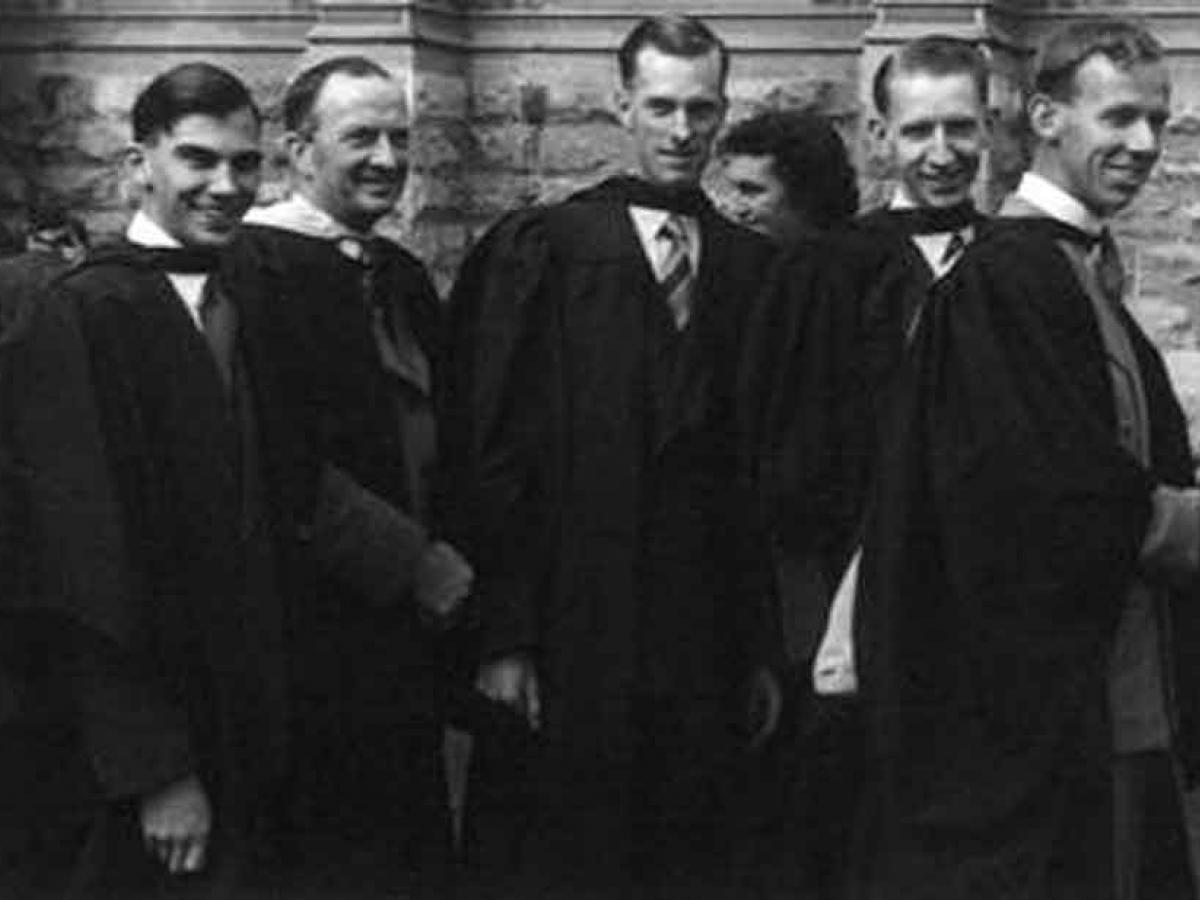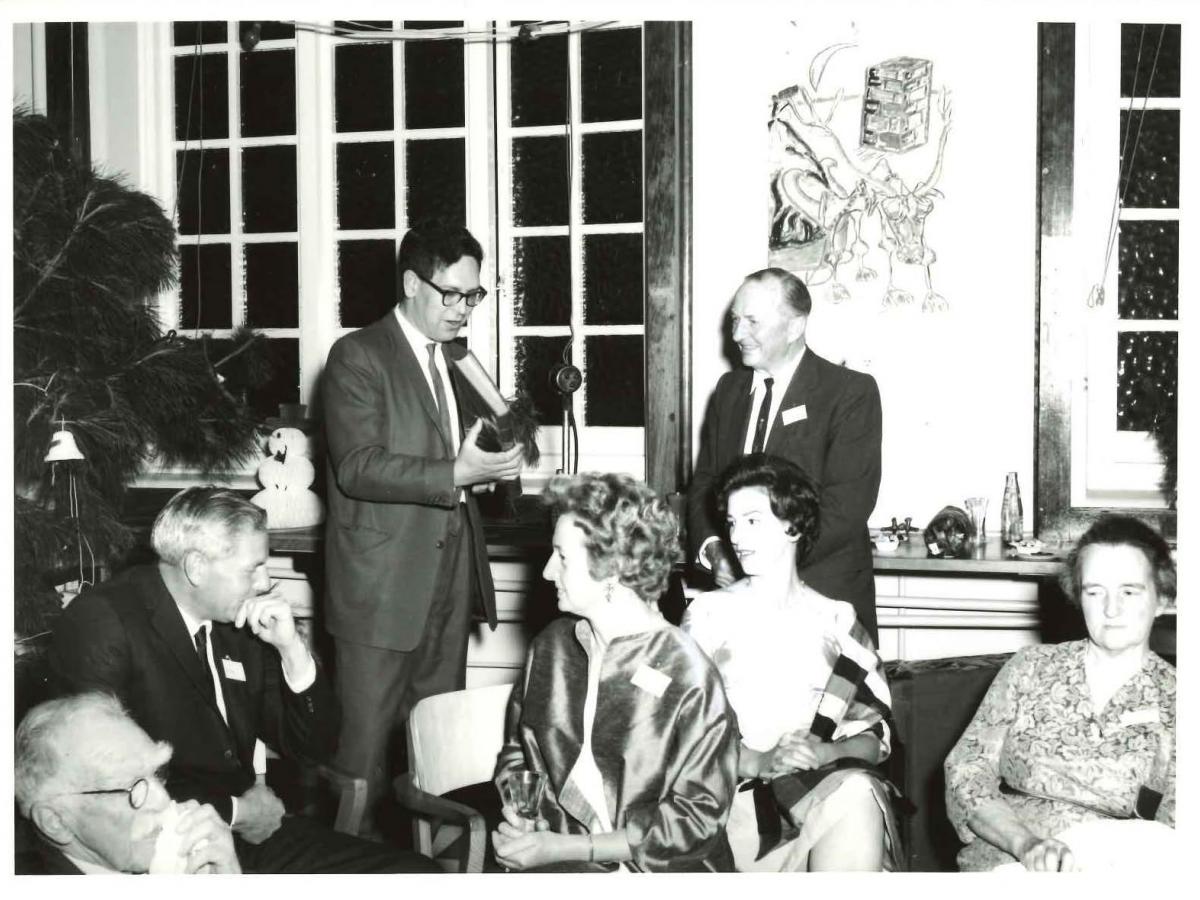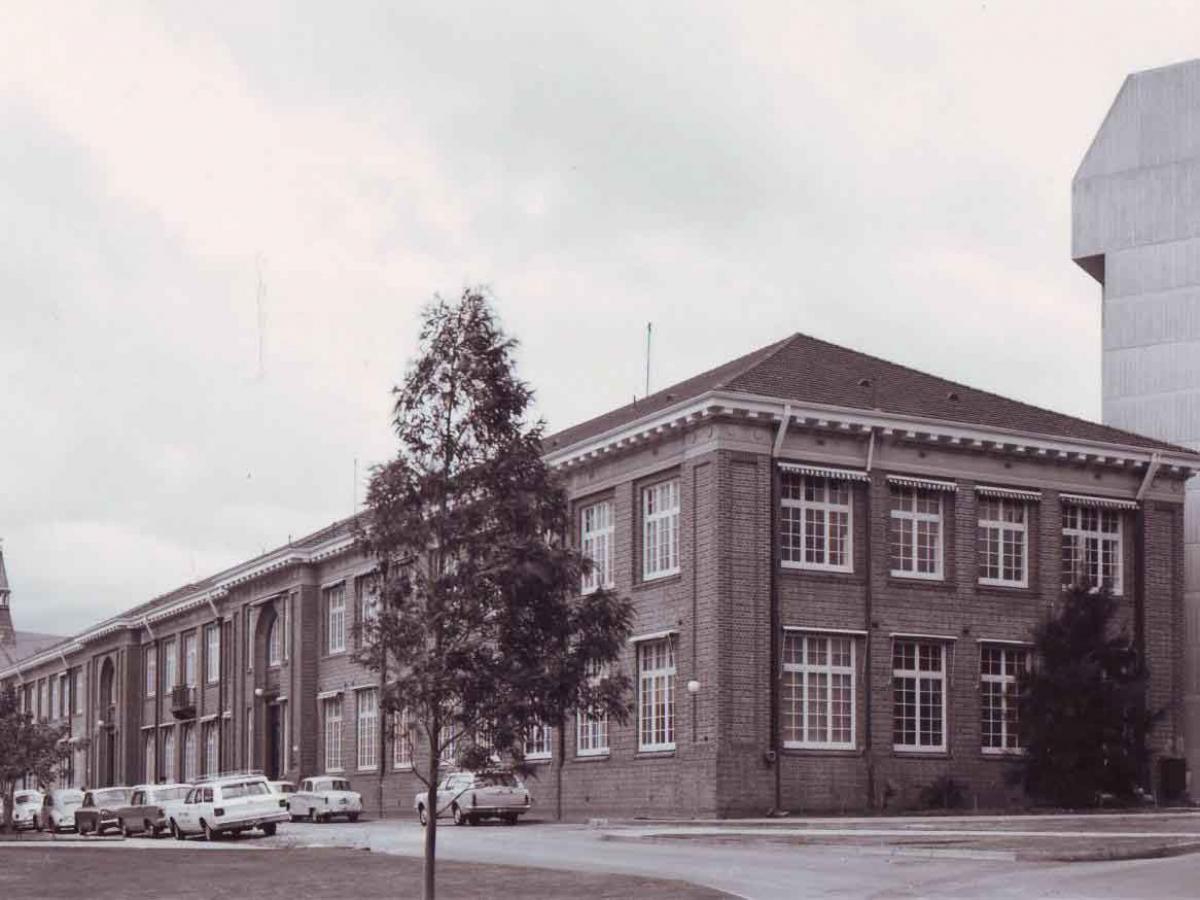Historical Records and Events

Early 50's.
Left to right: Bob Compton, George Fuller, David Sutton, Clare Sykes (background), Graham Elford, Gordon Aitchison
Alastair Blake is a former physics academic and Dean of Science at the University of Adelaide with a passionate interest in the history of our discipline at the University. He undertook a series of oral history interviews in 2011 and 2012 concentrating on the period following the retirement of Professor Kerr Grant in 1948. Transcripts of these fascinating interviews are available below. One result of Alastair's work is this fact-filled and very readable document titled
We are very grateful to the following people for generously giving their time for interviews with Alastair Blake to help with our history project.
- Iraj Afnan
- Harry Blevin
- Max Brennan
- Mary Carver (transcript)
- Bob Crompton (transcript)
- Don Creighton
- Graham Elford
- Malcom Elford (transcript)
- John Gascoigne (transcript)
- Alan Gregory
- Don Griffin (transcript)
- Angas Hurst (transcript)
- Barbara Kidman (transcript)
- Barbara Possingham (transcript)
- Don McCoy
- Harry Medlin (transcript)
- Perry Miles (transcript)
- Bob Nation
- Ted Radoslovich
- Robyn Storer
- Peter Teubner
1960's

1963: retirement presentation to Mr George Fuller after 38 years of service.
Left to right: Professor Sir Kerr Grant, Mr M I G Iliffe, Professor J H Carver, Mrs. Iliffe, Miss A Shierlaw, Mr G R Fuller.
After completing his history of Physics in Adelaide in the 1950s, Alastair Blake has continued with another investigation, this time of the 1960s. Again based on oral history interviews and his own detailed research, Alastair has produced a lively, beautifully written document of this important decade in our history.
You will not only find out about the Carver years in the Physics Department, but also the important work of the Department of Mathematical Physics and the Mawson Institute for Antarctic Research. The birth of the Physics Department at Flinders University is also described.
We are grateful to those people who participated in the oral history interviews with Alastair Blake. A list of those interviews for both the 1950s and 1960s are available above.
History symposium

Physics building, 1970
On September 1 2012, almost 200 people gathered for a day of reflection on the history of Physics at the University of Adelaide. The emphasis was on the period between the retirement of Sir Kerr Grant in 1948 until the beginning of the 1990s, though reference was made to both earlier and later periods.
Planning began for this event in 2011, the 125th anniversary of William Henry Bragg's arrival at the University. We recognised that the post-war history of Physics in Adelaide was not well documented, and efforts began to remedy the problem. One important initiative was taken on by Dr Alastair Blake, retired physicist and former Dean of Science, who conducted oral history interviews with more than a dozen former staff members and students, covering the 1940s, 1950s and 1960s.
These interviews informed some of the presentations at the Physics History Symposium. Transcripts of the interviews are available.
The audience at the Symposium were fortunate to see excellent presentations on our history. They are now available for to view, in the form of vodcasts, the presentation slides and other documentation. We hope that you will be interested in and surprised by what you learn about the outstanding physics that has been done at this institution over past generations by a band of fine physicists.
Bruce Dawson
Head of Discipline (Physics)
October 2012
-
Welcome (Bruce Dawson) and opening (Harry Medlin)
Harry Medlin was born in 1920 in Orroroo SA, and was educated in Orroroo and Adelaide. He attended the Adelaide Technical High School and the SA School of Mines before joining the Army in 1938 as a sapper in the Royal Australian Engineers. He rose to the rank of Captain, and served in Australia and Timor, before spending 3 1/2 years as prisoner of war in Timor and Java. In 1947 he was able to commence his studies at the University of Adelaide and completed an Honours degree in Physics in 1951, after which he was appointed as Lecturer in the Physics Department.
Harry completed his PhD in 1956 and went on to a distinguished career in the University, as a senior academic in Physics, a promoter of a myriad of causes, and ultimately as Senior Deputy Chancellor of the University. In recognition of his service, Harry was awarded Doctor of the University in 1997, the institution's highest honour. We are very pleased that Harry has been able to join us today, to say a few words to open our Physics History Symposium.
-
Physics in Adelaide - the 1950s, a decade of change - Alistair Blake
Alastair Blake graduated with a BSc(Hons) in Physics in 1963, and a PhD in 1967, both from the University of Adelaide, before travelling to the UK for a postdoc position at Imperial College. He returned to Adelaide in 1970 to a lectureship in physics.=
Alastair rose through the ranks, was Chairman of Physics more than once, and was Dean of the Faculty of Science from 1998-2001. We are very grateful that Alastair has taken up the challenge of this history project with great vigour. He has conducted oral history interviews with more than a dozen of our former colleagues and students, and has produced a wonderful history of the Physics Departments in the 1950s, available for download below.
-
Radiophysics - Iain Reid
As we have heard, Graham Elford was one of the bright young physicists who became lecturers around 1950. Graham went on to a distinguished career in the Physics department, formally retiring in 1988, though maintaining his research activity to the present day. Graham was a strong Chairman of Physics during an important part of the department's history from 1979-1985 about which we'll hear more about in the final talk of today.
Iain Reid is a young pup in relative terms. Iain obtained a Physics Honours degree in 1979 and a PhD in 1985 from the University of Adelaide, under the supervision of Basil Briggs and Bob Vincent. Iain spent some time in Canada before returning to a lectureship in 1988. Iain is now a professor, and Executive Dean of the University's Roseworthy Campus. He was awarded a D.Sc. in 2008.
-
Mathematical physics - Peter Szekeres
Peter Szekeres graduated with an Honours degree in maths from the University of Adelaide in 1961 and a PhD from King's College London in 1964. He worked at Cornell University, and had a lectureship at King's College, before returning to the University of Adelaide as a senior lecturer in the Mathematical Physics Department in 1971.
-
Fifty years of physics teaching from 1950 - John Patterson
John Patterson graduated with an Honours degree in Physics from this University in 1963, in the same class as Alastair Blake. He went on to a PhD at the ANU, and a postdoc at Caltech before returning to the University of Adelaide Physics Department in 1968. Until his retirement as a reader in 2000, John worked in the astrophysics group in a number of areas, including leading the Adelaide effort for the BIGRAT and CANGAROO gamma-ray telescopes.
-
Satellites, rockets and balloons - Ken McCracken
Ken McCracken earned his PhD from the University of Tasmania in 1959. He then spent 13 years in the United States at MIT, and as a professor at the University of Texas, where he was principal investigator on a number of space-based cosmic ray experiments, and balloon-based x-ray projects. He continued the x-ray astronomy as a Professor at the University of Adelaide during the period from 1965-1969. He then had a long career at the CSIRO as Chief of several divisions including The Division of Mineral Physics and the Office of Space Science before semi-retiring in 1989. Ken was the joint winner of the prestigious Australia Prize in 1995 for his work on remote sensing.
-
Cosmic rays and gamma-rays - Roger Clay
Roger Clay graduated with a PhD from Imperial College, London before travelling to Calgary in Canada to take up a postdoctoral position with John Prescott. When John came to Adelaide in 1971, Roger came too, first as a QEII Fellow, and soon after as a lecturer. Roger has just retired after 40 years in the Physics department, including several stints as head of physics, and a period as Dean of Science.
-
The physics discipline today - Anthony Thomas
Tony Thomas is a graduate of Flinders University who left Australia in the mid-70s to work at the University of British Columbia, the TRIUMF laboratory in Canada and CERN. In 1984 he took up a Chair in Physics at the University of Adelaide, and was appointed Elder Professor of Physics in 1989. Recently he has spent 5 years as Chief Scientist of the Thomas Jefferson Lab in the US, before returning to Adelaide in 2009 as an ARC Australian Laureate Fellow.
-
Closing remarks
Its time to close the day. I would like to thank you all for coming, especially those of you who have travelled long distances to be here. Thanks to all who have made this day possible - to members of our history committee, particularly Jeanette Roulston and Carol Maelzer for all their very hard work. I'd like to thank members of our administrative staff, particularly Mable Fong for their cheerful help. Thanks to Wayne England, Ben Menadue and Steven Saffi for the photography, and all of our student volunteers today. Special thanks to Alastair Blake for his enormous efforts in recording the history of the 1950s, and to all of those who have helped him with oral history interviews - they are listed on the back of the programme. Finally, many thanks to all of our speakers today - they have entertained and informed us, and reminded us of the huge legacy of Physics at this University.
